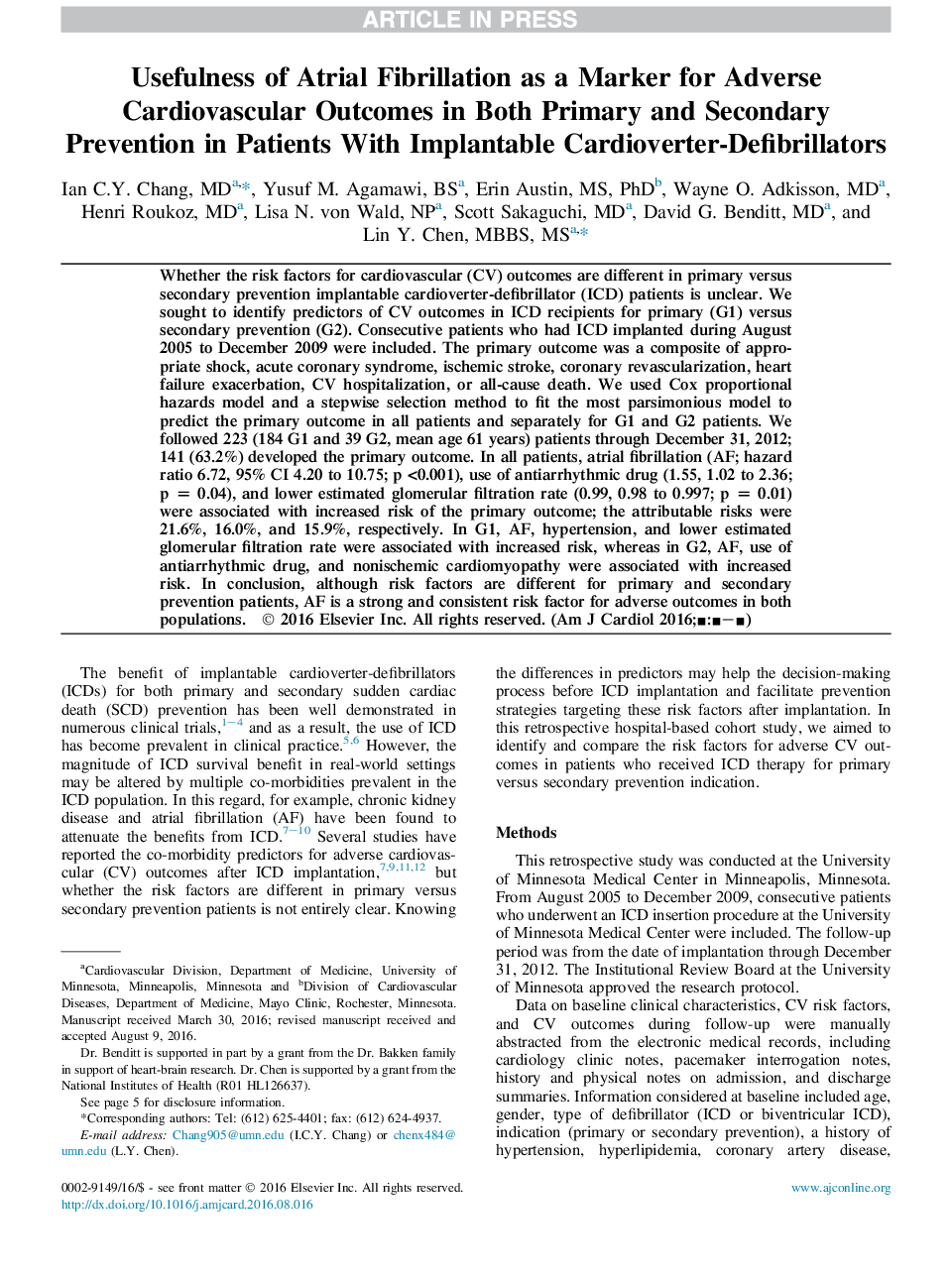| کد مقاله | کد نشریه | سال انتشار | مقاله انگلیسی | نسخه تمام متن |
|---|---|---|---|---|
| 5595527 | 1572100 | 2016 | 6 صفحه PDF | دانلود رایگان |
عنوان انگلیسی مقاله ISI
Usefulness of Atrial Fibrillation as a Marker for Adverse Cardiovascular Outcomes in Both Primary and Secondary Prevention in Patients With Implantable Cardioverter-Defibrillators
ترجمه فارسی عنوان
سودمندی فیبریلاسیون دهلیزی به عنوان نشانه ای برای پیامدهای قلب و عروق ناخواسته در پیشگیری از ابتلا به عفونت های اولیه و ثانویه در بیماران مبتلا به اختلال کاردیواتور-دیفیلریاتورهای ایمپلنت
دانلود مقاله + سفارش ترجمه
دانلود مقاله ISI انگلیسی
رایگان برای ایرانیان
موضوعات مرتبط
علوم پزشکی و سلامت
پزشکی و دندانپزشکی
کاردیولوژی و پزشکی قلب و عروق
چکیده انگلیسی
Whether the risk factors for cardiovascular (CV) outcomes are different in primary versus secondary prevention implantable cardioverter-defibrillator (ICD) patients is unclear. We sought to identify predictors of CV outcomes in ICD recipients for primary (G1) versus secondary prevention (G2). Consecutive patients who had ICD implanted during August 2005 to December 2009 were included. The primary outcome was a composite of appropriate shock, acute coronary syndrome, ischemic stroke, coronary revascularization, heart failure exacerbation, CV hospitalization, or all-cause death. We used Cox proportional hazards model and a stepwise selection method to fit the most parsimonious model to predict the primary outcome in all patients and separately for G1 and G2 patients. We followed 223 (184 G1 and 39 G2, mean age 61 years) patients through December 31, 2012; 141 (63.2%) developed the primary outcome. In all patients, atrial fibrillation (AF; hazard ratio 6.72, 95% CI 4.20 to 10.75; p <0.001), use of antiarrhythmic drug (1.55, 1.02 to 2.36; p = 0.04), and lower estimated glomerular filtration rate (0.99, 0.98 to 0.997; p = 0.01) were associated with increased risk of the primary outcome; the attributable risks were 21.6%, 16.0%, and 15.9%, respectively. In G1, AF, hypertension, and lower estimated glomerular filtration rate were associated with increased risk, whereas in G2, AF, use of antiarrhythmic drug, and nonischemic cardiomyopathy were associated with increased risk. In conclusion, although risk factors are different for primary and secondary prevention patients, AF is a strong and consistent risk factor for adverse outcomes in both populations.
ناشر
Database: Elsevier - ScienceDirect (ساینس دایرکت)
Journal: The American Journal of Cardiology - Volume 118, Issue 10, 15 November 2016, Pages 1497-1502
Journal: The American Journal of Cardiology - Volume 118, Issue 10, 15 November 2016, Pages 1497-1502
نویسندگان
Ian C.Y. MD, Yusuf M. BS, Erin MS, PhD, Wayne O. MD, Henri MD, Lisa N. NP, Scott MD, David G. MD, Lin Y. MBBS, MS,
